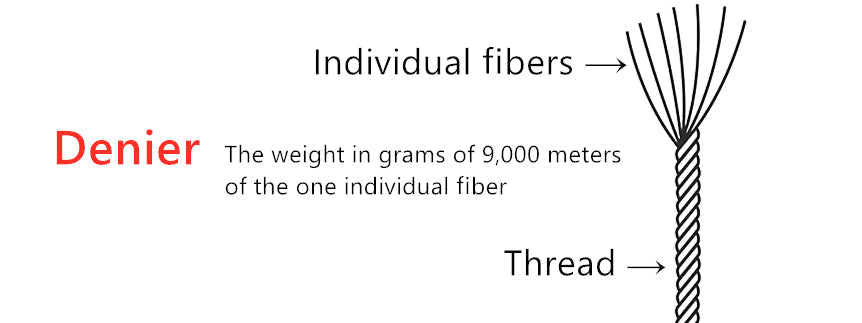
DENIER: A GUIDE TO OUTDOOR FLAG FABRICS AND THEIR FEATURES
Share
When we purchase embroidered and sewn striped flags, we often come across the Denier (D) indicator. What does this indicator mean? We will share it in detail through this blog post.
Table of Contents
· What Is the Concept of Denier?
Fabric is woven from threads, and threads are made up of individual fibers. The weight in grams of 9,000 meters of the individual fiber is this fabric's Denier.

A higher Denier value means thicker fibers, making the fabric stronger and more durable. However, this can also make the fabric heavier and less soft.
We can simply understand Denier as an indicator of fabric strength.
· Some Common Items And Their Typical Fabric Denier Values
- Silk: Usually around 8D to 30D, providing a super soft and delicate texture.
- Pantyhose/Tights: Typically between 10D and 40D. Lower Denier values offer a sheer appearance, while higher values provide more opacity and durability.
- Parachutes: Generally made from 30D to 70D fabric, emphasizing lightweight and strength.
- T shirt: Range from 30D to 100D, take into account both comfort and warmth.
- Outdoor flag: Range from 150D to 300D, need to be light enough to float in the breeze, yet durable enough to hang for a long time, won’t be easily torn in strong wind.
- Backpacks: Often range from 200D to 1000D. Lightweight backpacks might use lower Denier fabrics, while heavy-duty backpacks use higher Denier for increased durability.
- Upholstery Fabric: Typically ranges from 300D to 1200D, offering strength and durability for furniture use.
- Luggage: Typically uses 600D to 1680D fabric to withstand wear and tear during travel.
· What Are The Common Fabrics For Embroidered And Sewn Striped Flags?
- The most popular fabric for outdoor flags is 200D nylon, followed by 210D polyester. Nylon American flags sell twice as much as polyester flags each month. Together they account for about 80% of all outdoor flag sales.
- 2-ply polyester and 300D polyester are also common fabrics.
- 150D polyester is a new specification that has just appeared in recent years.
· What Are The Correct Ways To Use Different Fabrics Flags?
To better use and maintain outdoor flags, it is essential to consider three core factors: Beaufort wind scale, UV intensity, and rainfall.
|
Flag fabric |
Beaufort Scale |
UV Index |
Rainfall |
|
200D nylon |
Calm → Light Breeze |
8 and below |
Annual Rainfall 20” and up |
|
210D polyester |
Light Breeze→ Moderate Breeze |
Little impact |
Little impact |
|
2-ply polyester or 300D polyester |
Moderate Breeze →Strong Breeze |
Little impact |
Little impact |
|
150D polyester |
Calm→ Light Breeze |
Little impact |
Little impact |

· Take The American Flag, For Example
- When the UV index exceeds 9, the molecular bonds of nylon will be destroyed, causing irreversible damage;
- Nylon fabrics are prone to static electricity. In an environment with little rainfall, because the air is too dry, the static electricity accumulated on the nylon flag cannot be released for a long time, which will also damage the molecular bonds of nylon;
- In low wind speeds but high UV index conditions such as summer, western deserts, and areas with heavy rainfall such as the West Coast, 150D polyester is the best choice and it is cheaper than nylon flag, and its price is only 60% of nylon flags;

- New England and the Mid-Atlantic regions often experience low winds and lower UV radiation even during the summer, making them ideal areas for flying 200D nylon flags. Of course, if cost efficiency is a consideration, 150D polyester is also a very good choice;

- The South Atlantic has low wind speeds year-round, ideal for nylon flags. However, high summer UV intensity suggests using polyester flags from May to August, and nylon flags the rest of the year, to ensure durability and maintain the condition of the flags;

- Similarly, Northern California experiences low winds year-round and over 30" of annual precipitation, but strong summer UV rays. Therefore, it's best to use a combination of flags too: polyester flags during summer for UV resistance, and nylon flags during other seasons for optimal performance.
The United States' diverse climate necessitates strategic flag use. Combining nylon and polyester flags based on seasonal conditions enhances flag longevity and optimizes budget efficiency.
Use different flags in various seasons to achieve all-weather display as much as possible.
